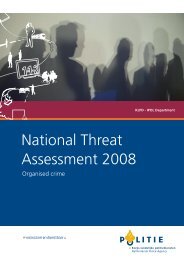Assessing the Effectiveness of Organized Crime Control Strategies ...
Assessing the Effectiveness of Organized Crime Control Strategies ...
Assessing the Effectiveness of Organized Crime Control Strategies ...
You also want an ePaper? Increase the reach of your titles
YUMPU automatically turns print PDFs into web optimized ePapers that Google loves.
<strong>Assessing</strong> <strong>the</strong> <strong>Effectiveness</strong> <strong>of</strong> <strong>Organized</strong> <strong>Crime</strong> <strong>Control</strong> <strong>Strategies</strong>:<br />
A Review <strong>of</strong> <strong>the</strong> Literature<br />
4.7 Witness Protection Programs<br />
These programs are designed to protect witnesses who testify in cases involving OC. They<br />
provide for <strong>the</strong> health, safety, and welfare <strong>of</strong> <strong>the</strong>se witnesses, as well as <strong>the</strong>ir families. Such<br />
programs may involve <strong>the</strong> relocation <strong>of</strong> witnesses and <strong>the</strong>ir families, and <strong>the</strong> provision <strong>of</strong> new<br />
identities and jobs. In <strong>the</strong> United States, <strong>the</strong> program has stretched resources, as <strong>the</strong> number <strong>of</strong><br />
individuals protected by <strong>the</strong> program has been far in excess <strong>of</strong> that anticipated. By <strong>the</strong> end <strong>of</strong><br />
1996, 6,500 witnesses and 15,000 dependents had entered <strong>the</strong> program (Sabbag, 1996). The<br />
annual cost exceeds $25 million, well in excess <strong>of</strong> <strong>the</strong> original estimate <strong>of</strong> less than $1 million<br />
(Albanese, 1996:193).<br />
A major criticism <strong>of</strong> such programs is that <strong>the</strong>y provide career criminals with “clean”<br />
backgrounds that <strong>the</strong>y can use to prey on an unsuspecting public (Abadinsky, 2003). This is<br />
especially a concern as <strong>the</strong> allowance provided by <strong>the</strong>se programs tends to be far more modest<br />
than <strong>the</strong> income <strong>the</strong>se individuals can typically generate from crime. There are many<br />
documented cases <strong>of</strong> witnesses committing major crimes with <strong>the</strong> help <strong>of</strong> <strong>the</strong>ir new identities<br />
(Abadinsky, 2003:335). Ano<strong>the</strong>r serious concern is that estranged spouses <strong>of</strong> those protected by<br />
<strong>the</strong> program have encountered difficulties visiting and maintaining a relationship with <strong>the</strong>ir<br />
children (Tulsky, 1987). Fur<strong>the</strong>rmore, <strong>the</strong> US Department <strong>of</strong> Justice does not always receive <strong>the</strong><br />
cooperation <strong>of</strong> o<strong>the</strong>r federal agencies in obtaining military records, social security cards, medical<br />
records, and o<strong>the</strong>r documents (Rhodes, 1984:183; Ma<strong>the</strong>ws, 1990).<br />
Rhodes (1984) asserts that <strong>the</strong> US program is largely tailored to career criminals and may not<br />
serve non-<strong>of</strong>fenders as well. He describes a case in which a New York City businessman, upset<br />
with his bro<strong>the</strong>r’s narcotics addiction, testified against OC figures with whom he had some<br />
legitimate contact. His information helped obtain <strong>the</strong> conviction <strong>of</strong> several racketeers and his<br />
courage was rewarded by advice provided by <strong>of</strong>ficials from <strong>the</strong> Witness Protection Program that<br />
he ought to hastily sell his lucrative business and home, and relocate to Texas. He was also<br />
advised to terminate any direct contacts with friends and relatives. The witness eventually<br />
committed suicide. This story and o<strong>the</strong>rs like it suggest that <strong>the</strong>re may be fewer incentives for<br />
non-criminals to participate in witness security programs (Mitchell, 1981). Many witnesses find<br />
<strong>the</strong> process <strong>of</strong> changing <strong>the</strong>ir identities and concealing <strong>the</strong>ir past highly stressful (Montanino,<br />
1984: 503).<br />
These programs do, however, appear to afford protection. From 1961-1965, prior to <strong>the</strong><br />
establishment <strong>of</strong> <strong>the</strong> US program, <strong>the</strong> US Department <strong>of</strong> Justice lost more than 25 informants in<br />
OC cases (Kelly, Schatzberg, and Chin, 1994: 497). Hundreds <strong>of</strong> o<strong>the</strong>r prosecutions were<br />
stymied because witnesses feared for <strong>the</strong>ir lives. While about 30 witnesses who have left <strong>the</strong> US<br />
program have been murdered, none following program guidelines have met this fate (Sabbag,<br />
1996). (Ano<strong>the</strong>r source indicates that a protected witness in a drug case was murdered in<br />
Arkansas (Mitchell, 1981)). The program boasts a 97 percent success rate in protecting<br />
witnesses under supervision (Lyman and Potter, 1997:433).<br />
Montanino (1990:127) asserts that, “Of all <strong>the</strong> [US] government’s strategies for combating<br />
serious criminality, <strong>the</strong> Federal Witness Security Program has been <strong>the</strong> most successful.”<br />
Giuliani (1986:115) adds that, since <strong>the</strong> program was established in 1970, virtually every major<br />
32 | Research and Statistics Division / Department <strong>of</strong> Justice Canada








